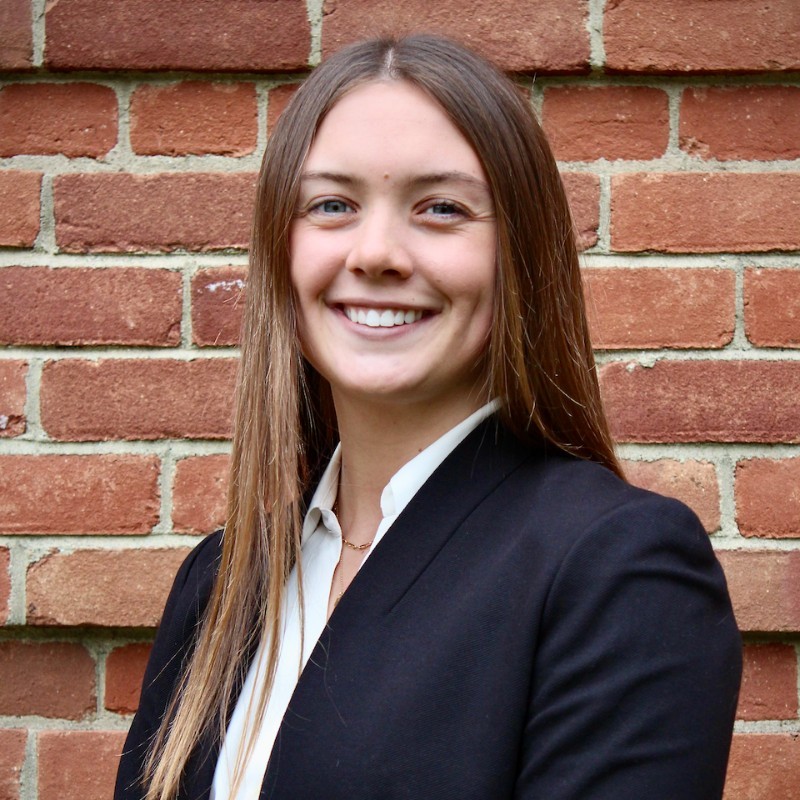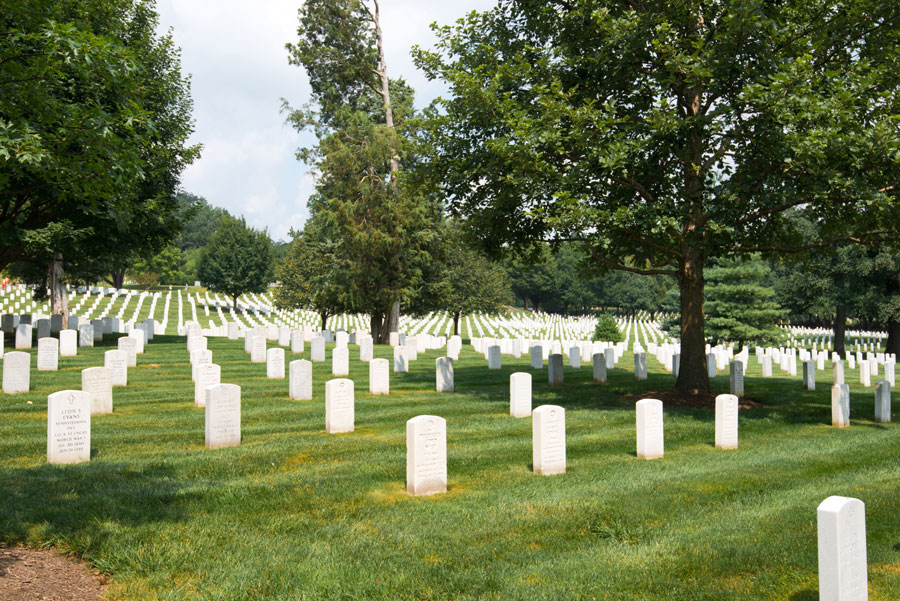An obituary is a news article that reports the recent demise of a person.
It typically accounts for that person’s life, family members, nice tributes, great achievements, and the information on the funeral service. The main purpose of an obituary honour and aggrandize the life of the deceased. It faintly guides human behaviour on how to behave while alive and how to be remembered positively—also, this acts as a death notice.
During the hard times when mourning your loved one’s death, it may not be easy for someone to remember everything to include in the obituary. Death is painful to everyone, but you need to honour the dead for the last time as you mourn. The best thing is to use an Obituary template or an example to ensure you do not skip something important. An Obituary example or a template will help you write a clean and well-informed obituary without skipping anything. Remember, this is the last honour, so you need to make it perfect. Also, it eases things for you during hard times.
Free WTO Exclusive Templates
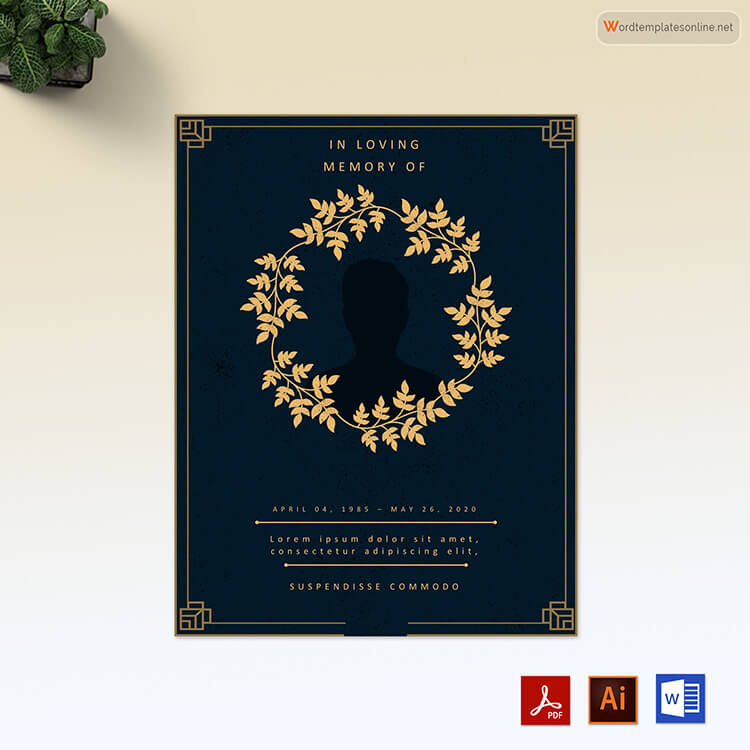

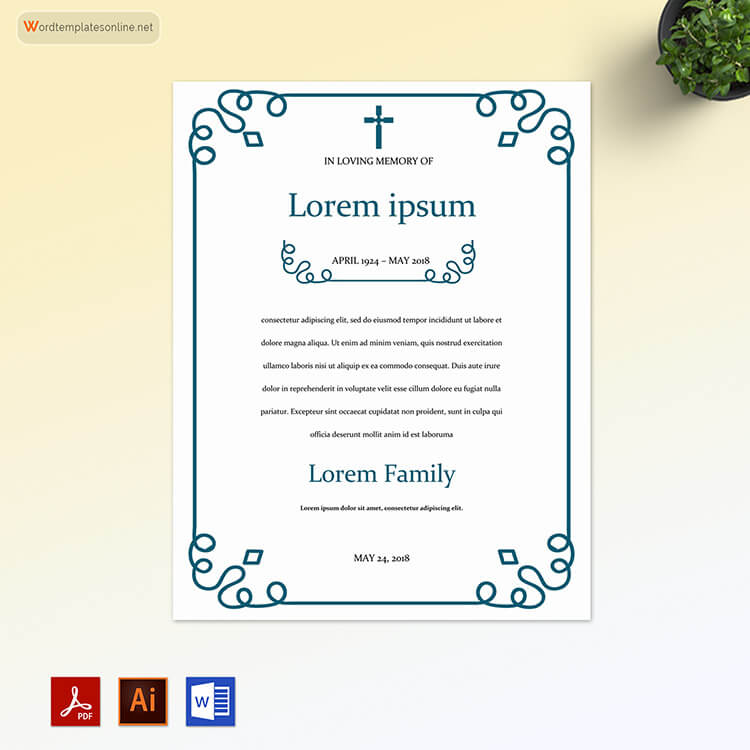
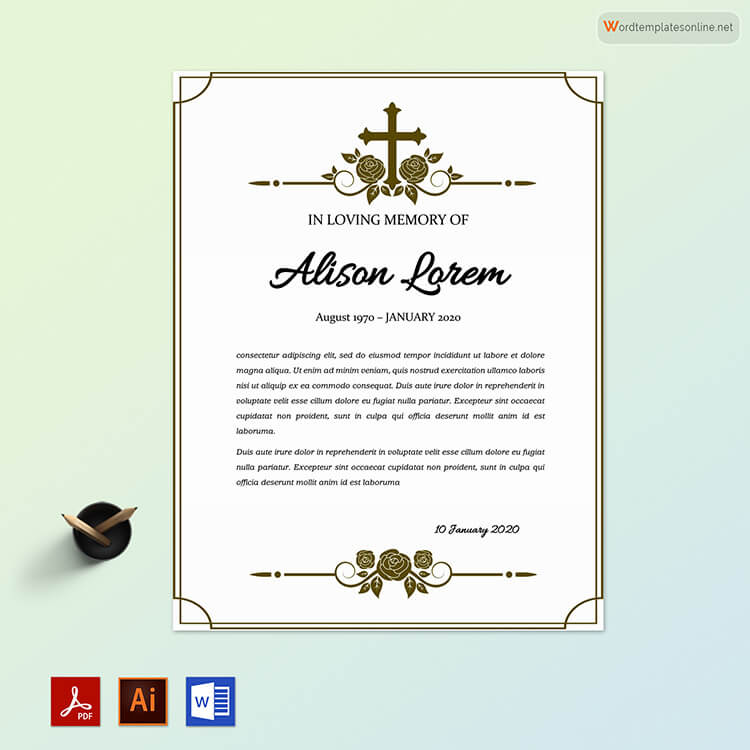
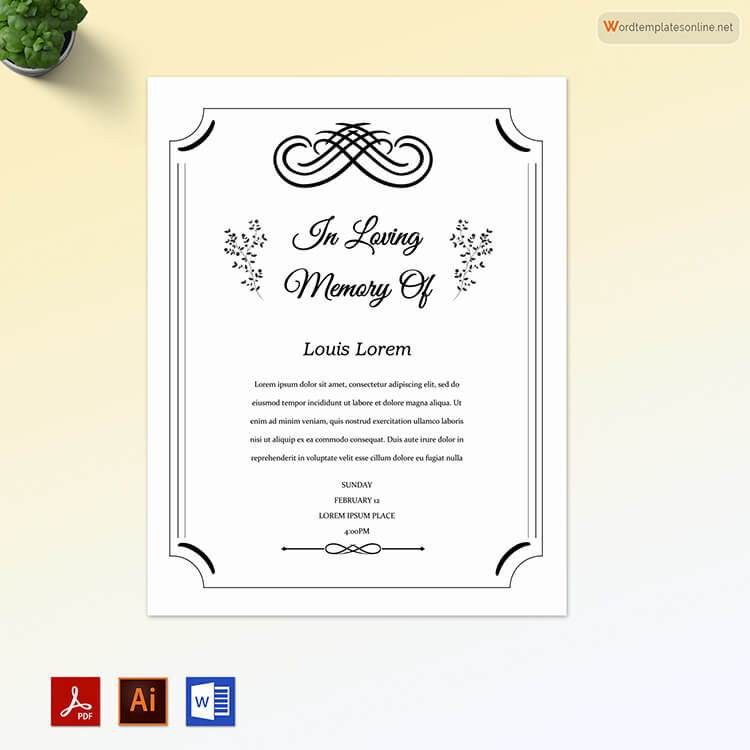

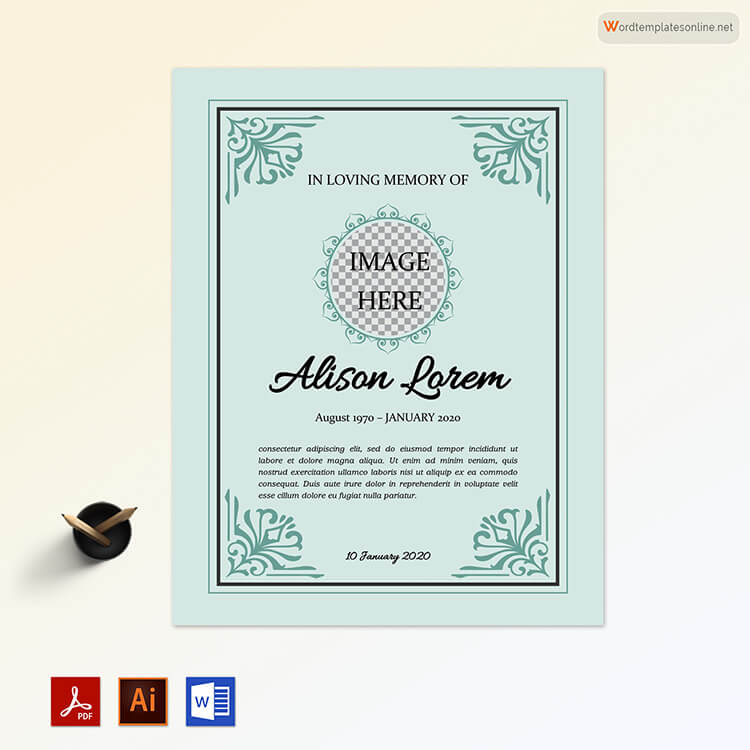
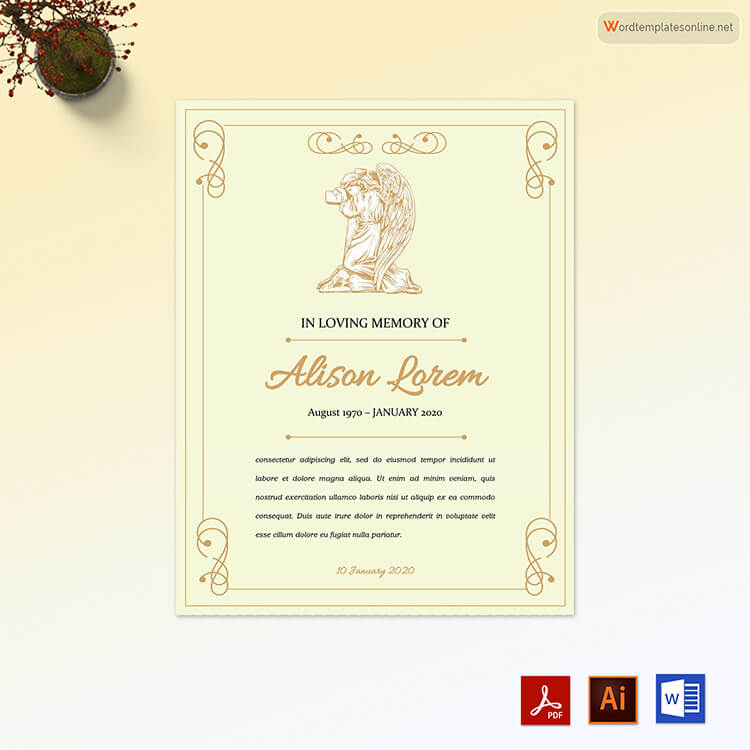
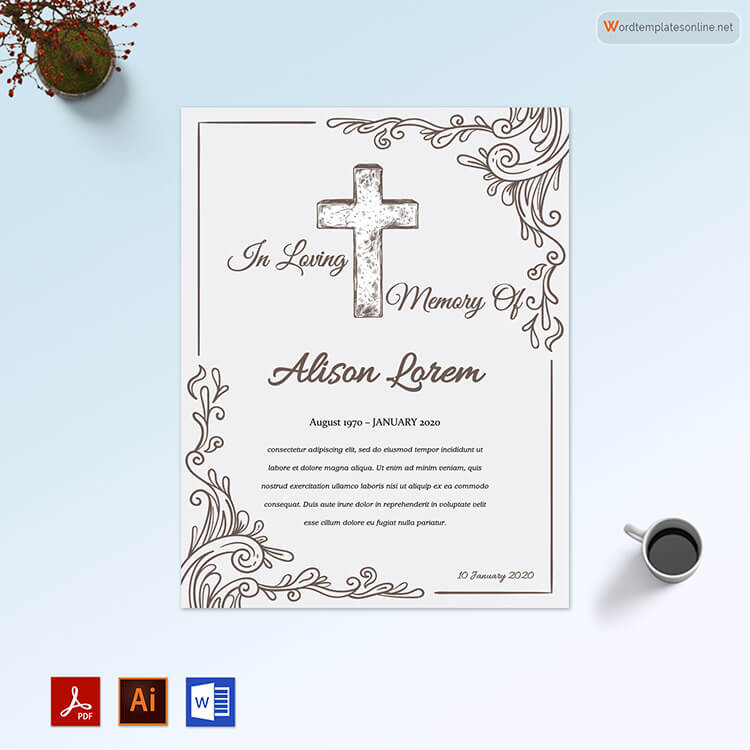
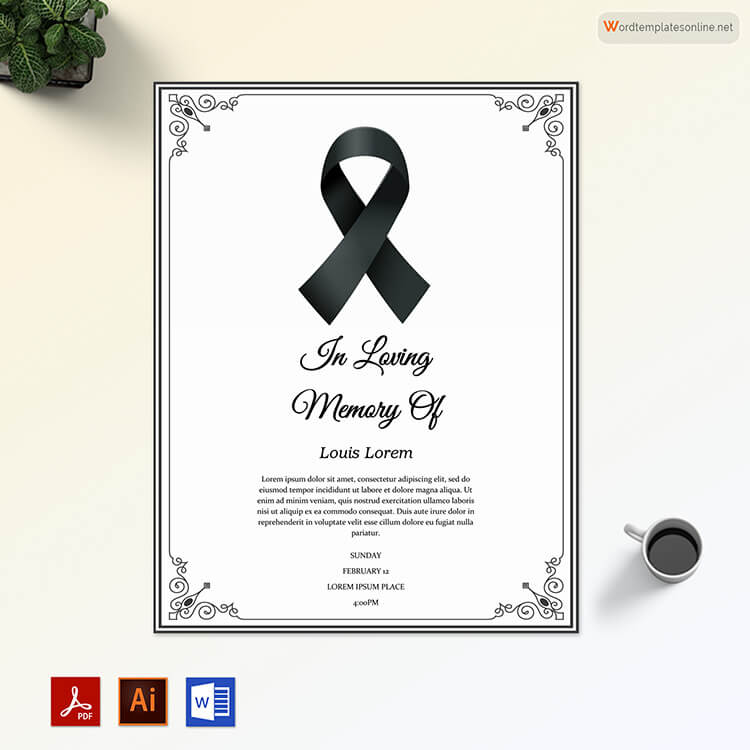
Basic Contents of Obituary Program Template
The basic information of an Obituary program template includes the:
- Name
- Dates
- Cause of death
- List of loved ones
- Resume details
- Membership organizations
- Hobbies and interests
- Charities
- Funeral arrangement
- humour
- positivity
- place of history
The arrangement: the format should follow Death announcement, Biographical Sketch, Family service time, Special message, and photos. All the above content falls under these subtitles.
How to Write an Obituary
Step 1. Consult a local newspaper
Before you begin writing, it is critical to consult the local newspaper. Many newspapers have guidelines on the style and length of the obituary. Besides, most of them accept obituaries written by their staff or submitted from a funeral home. Once you consult and agree with them, move on, and begin writing.
Step 2. Death announcement
Begin with the name of the deceased, age, residence alongside the time and place of death. The identifying statement of death can be passed in several ways; for instance, Died, passed on, went to be with the creator, the list is big. Some people feel like using the phrase dead is so blunt and therefore goes for the flowery phrases. However, this depends on you. Go for what is comfortable with you. Indicating the cause of death in the obituary depends on you. However, have in mind that many obit readers will be curious to know the cause. If you are comfortable to share, go ahead and include it.
Step3. Biographical Sketch
The keyword here is the sketch. You should not include everything since an obituary is not a biography. So it should only recount the most critical events, abilities, contributions, and connections in the diseased; everyone has a unique life. Still, general milestones include the birth dates and birth, parent’s names, place, and date of marriage, spouse, education, and occupation. Nevertheless, an obituary is not a legal document, so you can include or omit anything you feel is not important. It would help if you also mentioned the contributions and recognition of the dead. In case they are many, choose the greatest.
Step4. Family
It knows that a funeral is the living, well an obituary is for the living also. So one of the most critical parts of an obituary is the list of survivors who preceded your loved ones to death. So in the confusion and occupation of death, do not forget the close family members. You may omit their hobbies and interests but do not forget the family.
Step 5. Service Times
The local traditions vary from one country to another, so you need to consult your local papers to give you the exact order of service times. However, you can still do this part for the funeral director. However, you need to include the essential information. That is the time, full date, and place where the service will take place. Also, include the officiant name. Do not forget the place and the dates of the burial.
Step 6. Special Messages
It is cool to have a special message at the end of the obituary. For instance, Special Thanks to the hospital staff, or we will retain your memory in our hearts. You may also include a short prayer or a short poem.
Step 7. Photos
Photos may incur an extra cost but are a satisfying souvenir of the deceased. Further, it is an easy way for people to recognize diseases among other obituaries. Include the old and the newest photos to show the life they passed on enjoying.
Tips for Writing a Memorable Obituary
Writing an obituary for someone close and dear to you is an overwhelming task. Your grief is personal and unadulterated. No one else feels the same grief as you. The mourning reflects the nature and meaning of your special relationship with the person who passed away. It should be written in a way that infuses this bereaved and important remembrance with key appropriate details and phrases that sincerely portray the nature of the person being revered.
Write down key details first
The purpose of writing an obituary is to inform the public of an individual’s passing. Therefore, the obituary should share the key information about the person who has died. His full name, birthday, birthplace, date of demise, age, residence address at the time of death, and cause of death can be mentioned, but it’s optional. In case of the death of a woman, her maiden name should also be mentioned.
Make a list of important members of the deceased person’s family. For example, if the deceased person was married, his/her spouse’s name, whether alive or dead, should be mentioned.
An obituary contains the deceased person’s biographical sketch, essential events in the deceased life, qualities, contributions, and lifetime accomplishments. Mention earlier triumphs first, then follow the timeline of their life. Finally, mention 3-5 key accomplishments to have a motivating effect.
Write in present tense
The best way to draft an obituary is to write it in the present tense. This way, the writer feels as if the deceased person is right in front of him. Thus, he has a direct bonding with him.
Write in letter form
Write the initial draft in letter form. The entire letter is left justified and single-spaced except for a double space between paragraphs. When writing, imagine as if you are writing about the deceased person to his family and telling them how good a person he is.
Ask friends and family for memorable stories
To make the obituary filled with tributes, stories, and events depicting the deceased person, ask friends and relatives of the deceased about the stories that show his kindness, generosity, caring and loving nature, and many other traits that only they know and should share with other people. In addition, they can share his funny moments and how he made other people laugh.
Ask yourself these questions about your dearest friend
Before writing a tribute, one can ask themselves questions about the deceased. For example, how would you portray your friend as a human and what kind of person he was toward people around him? You can also mention your best reminiscences and the fun you had during your school days.
Write down the things you miss the most about your beloved friend, like any song he used to sing, which reminds you of his memory. Then, ask yourself the best things that you will cherish about your friend. There can be many habits e.g., things that the deceased person disliked, and how he smiled, etc.
Avoid humour
Sometimes the deceased person is known for his sense of humour. So, telling some of his jokes can be tempting. However, writing an obituary is a serious matter. Therefore, one should write about the deceased person in a way that inspires others.
Check the facts
When writing an obituary, details, and facts about the deceased person are the most important. If inadvertently you misspell the deceased’s name or if the address of the funeral place is wrongly printed, it will create a huge embarrassment both for the organizer and the family.
It is of utmost importance that all names and dates are meticulously gone through, again and again. Check the deceased person’s full name. Also, make sure the names of all of the deceased person’s family members, far and near, are included, and all names are correctly spelled. Make sure that middle names and the maiden name in case the deceased is female are correctly mentioned. All suffixes attached to a name like Jr., M.d., Prof., Col., etc., are also written.
There can be spelling and grammatical mistakes and omissions. Therefore, it is always better to have the final version proofread by someone close to the deceased’s family to avoid any untoward confusion.
Proofreading
Experts suggest that reading backward enables us to catch spelling errors. In backward reading, you start to read one word from the end line of the written draft to the beginning in reverse order. Spell check is reliable up to a certain extent. Read the Obituary Loud for when the text is read loudly; a lot is heard and simplified. Moreover, verb tense errors become more apparent when reading aloud.
Also try to let another person do the final proofreading. The second person could have a fresh mind and will pinpoint the mistakes better than a bereaved writer could. It is also suggested to give an Interval after the first check. Another important proofreading tip would be to have a printed copy in large font size as the laptop screen is very bright and your eyes may get tired easily.
Publish the obituary
Before writing the obituary, check the local newspaper for any publication requirements like the number of obituary words and the cost per word. Also, check for format requirements of different newspapers.
More Examples & Samples
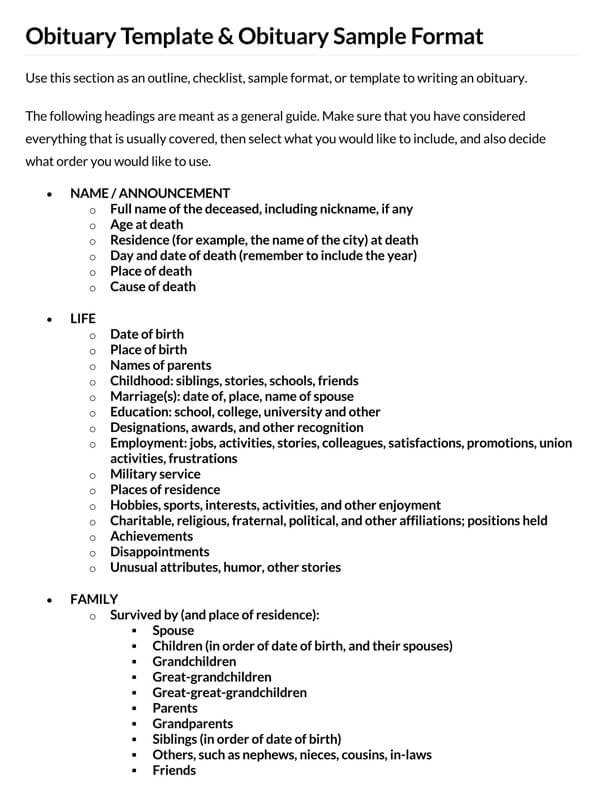
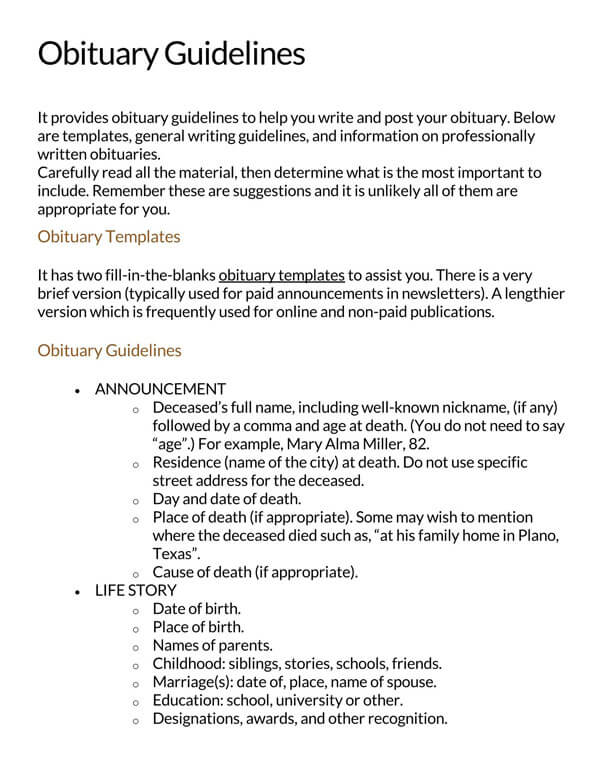
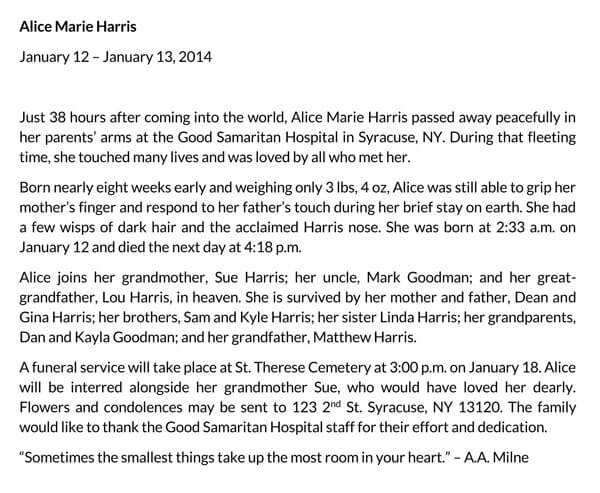
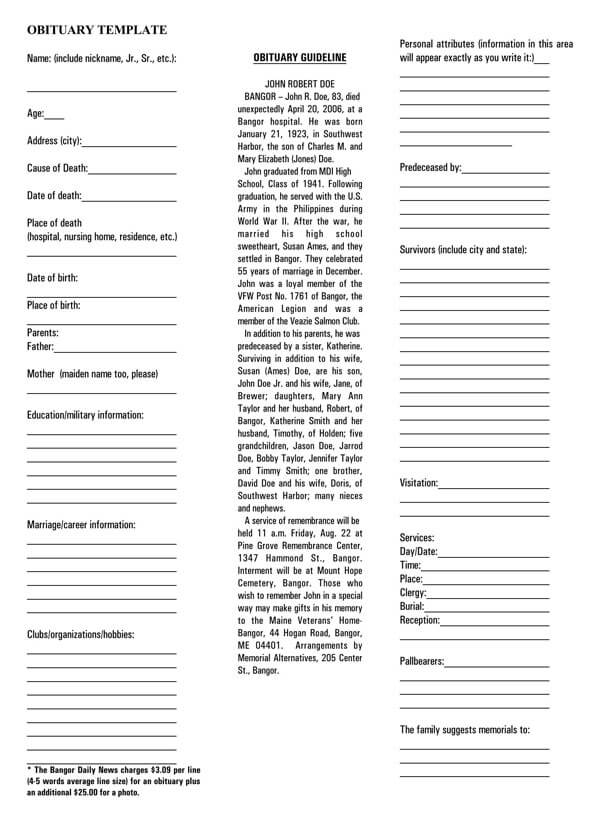
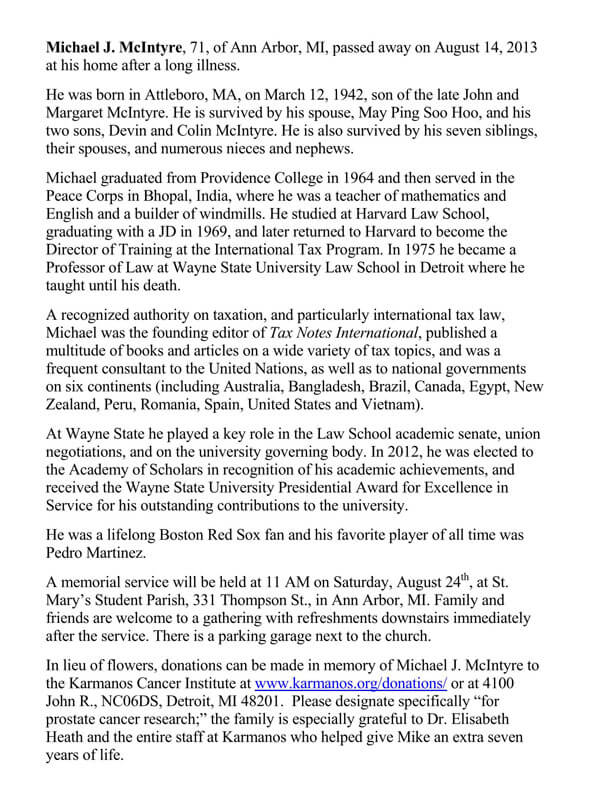
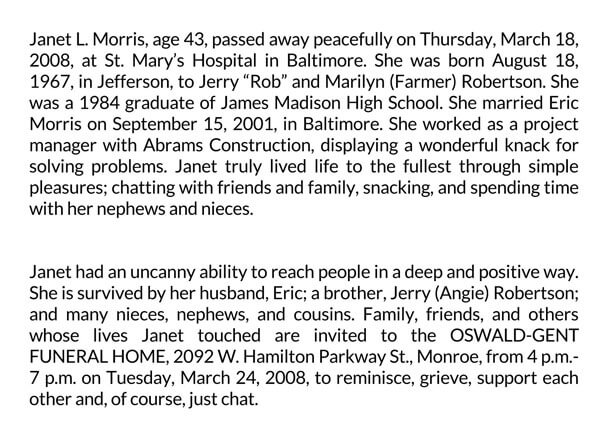
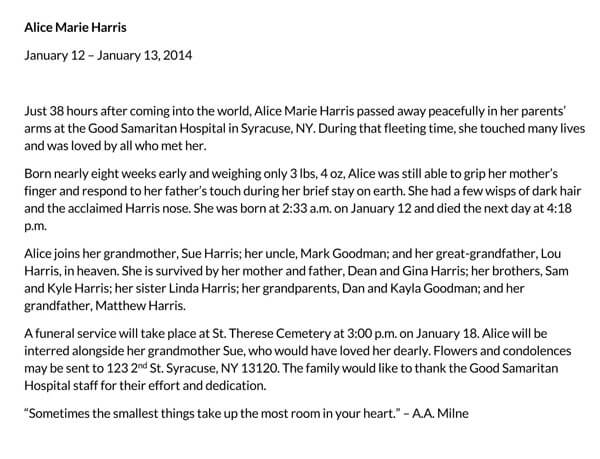

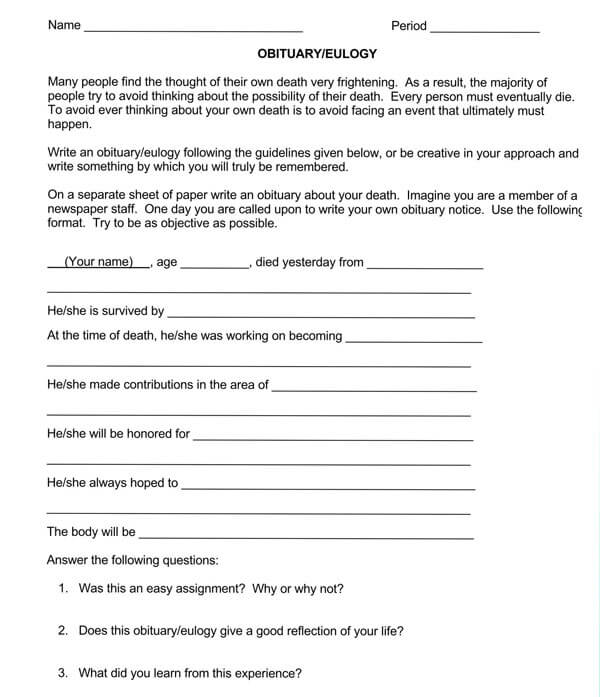
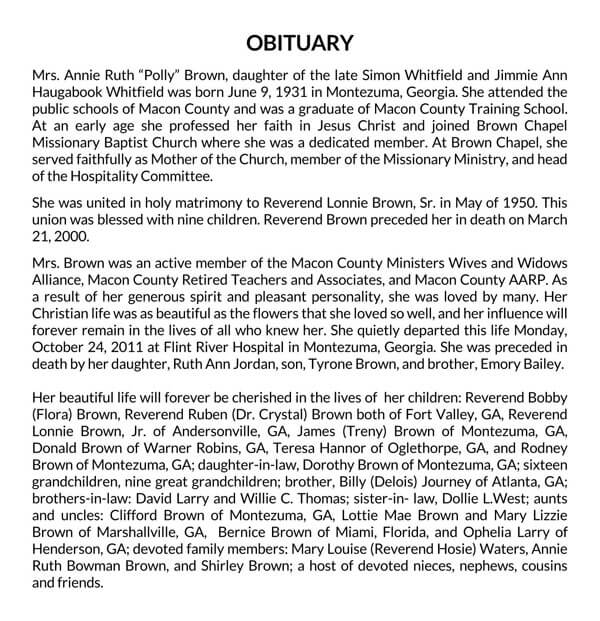
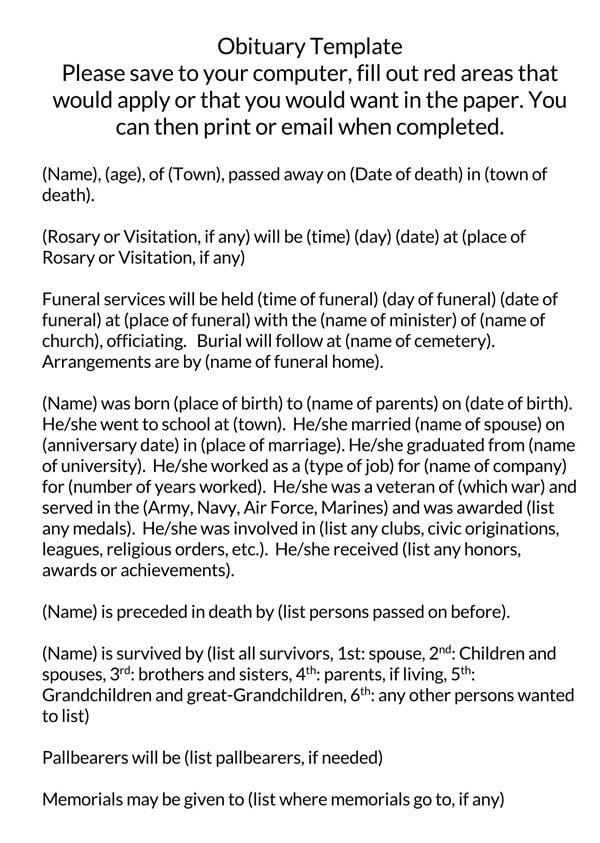
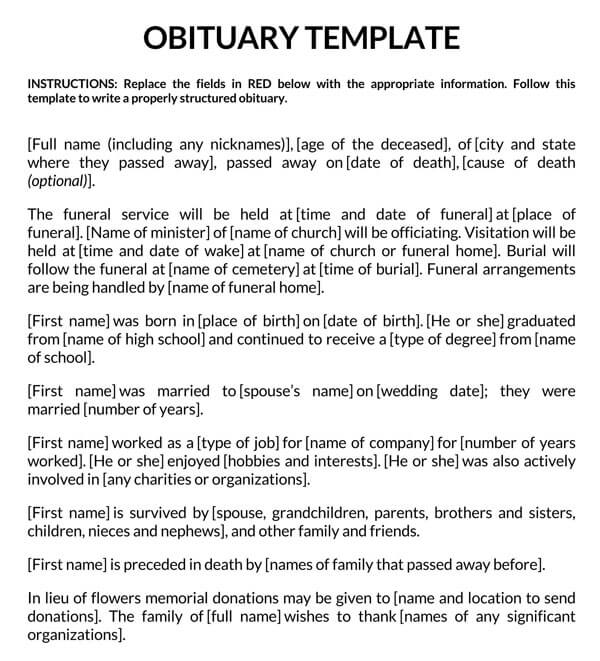
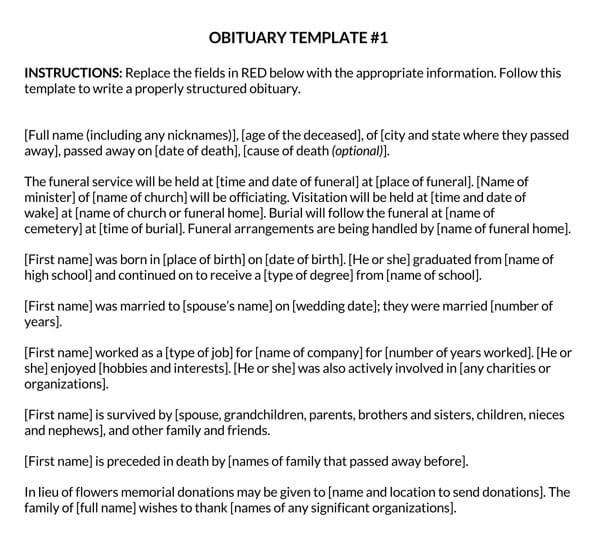
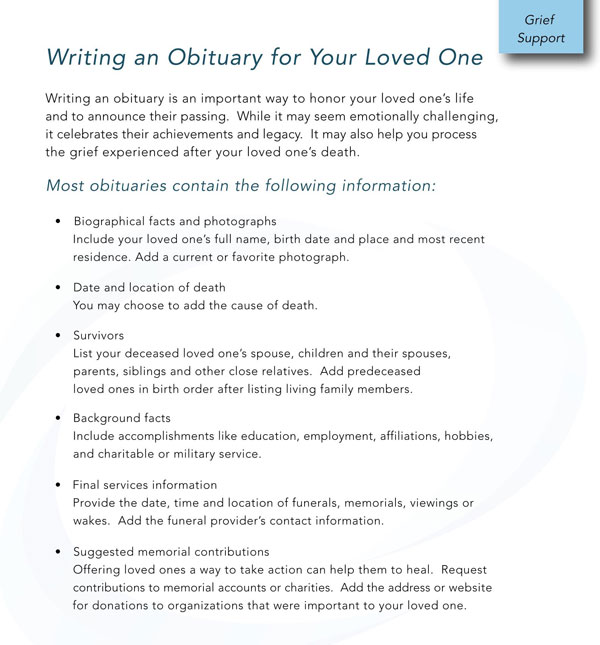
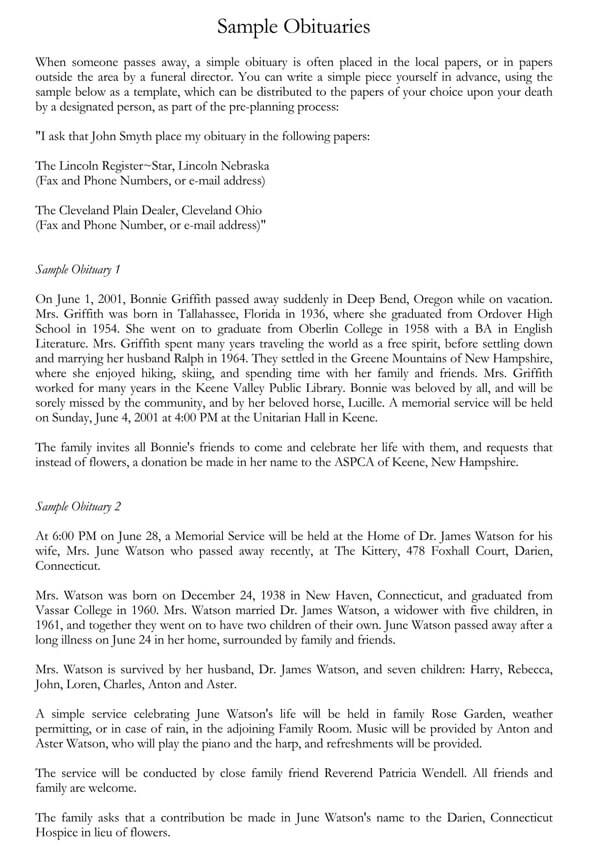
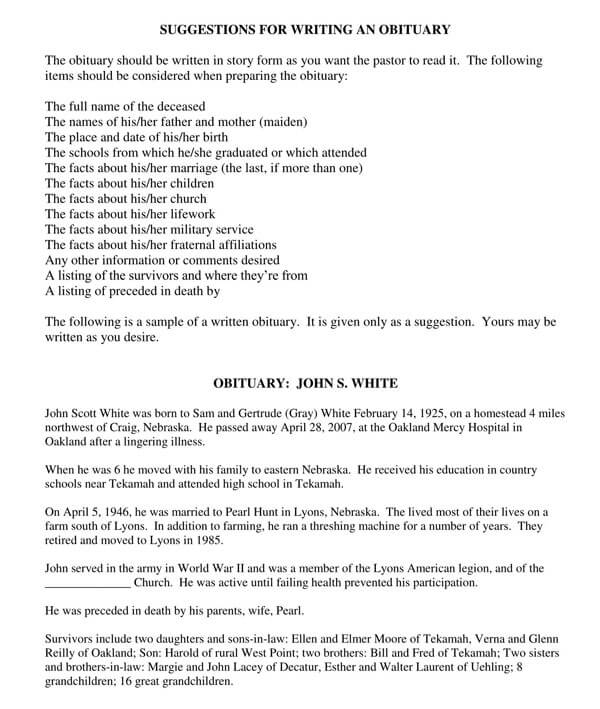
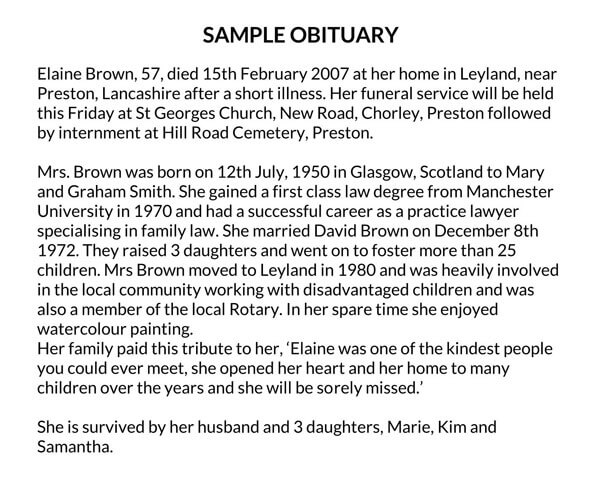
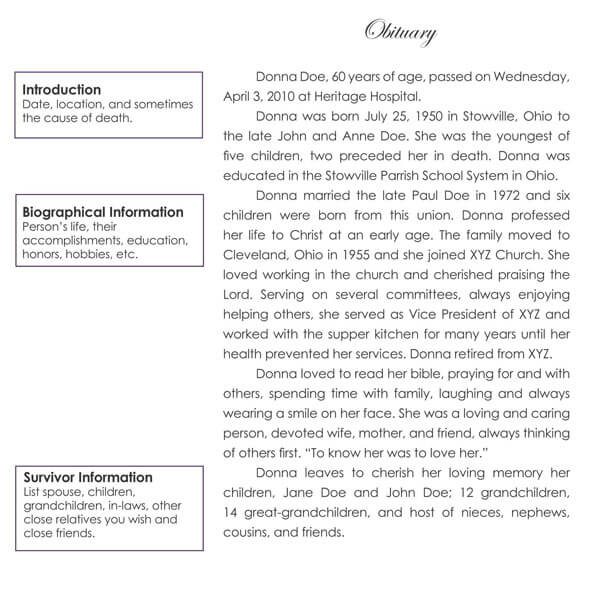
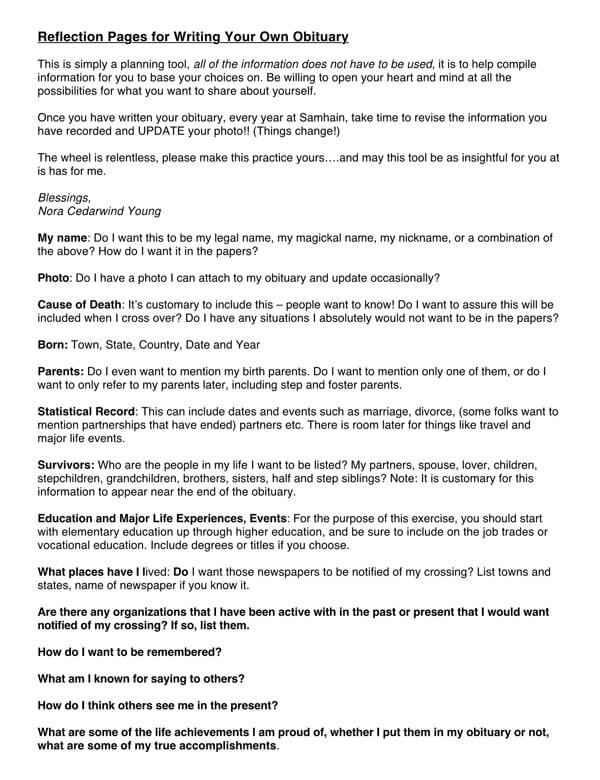
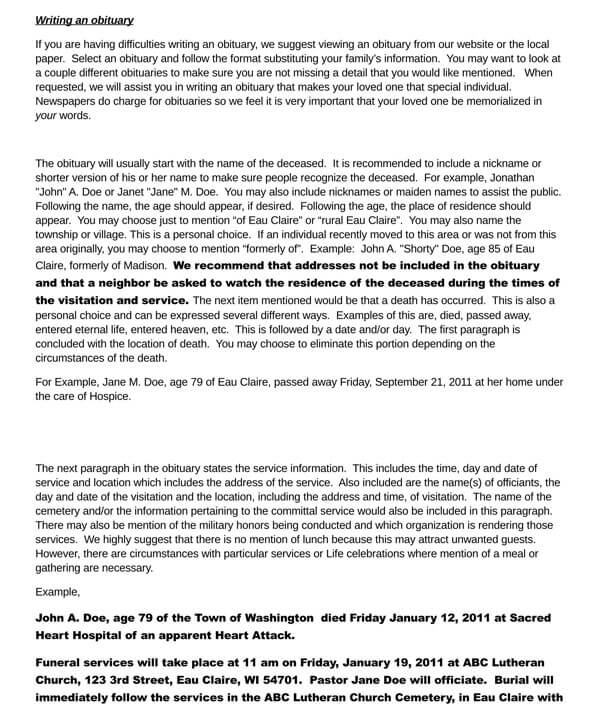
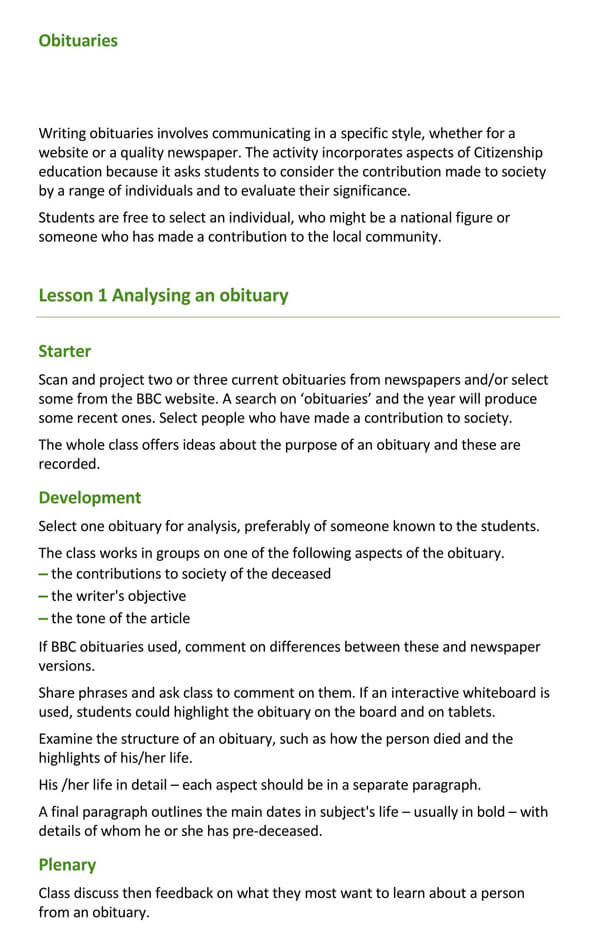
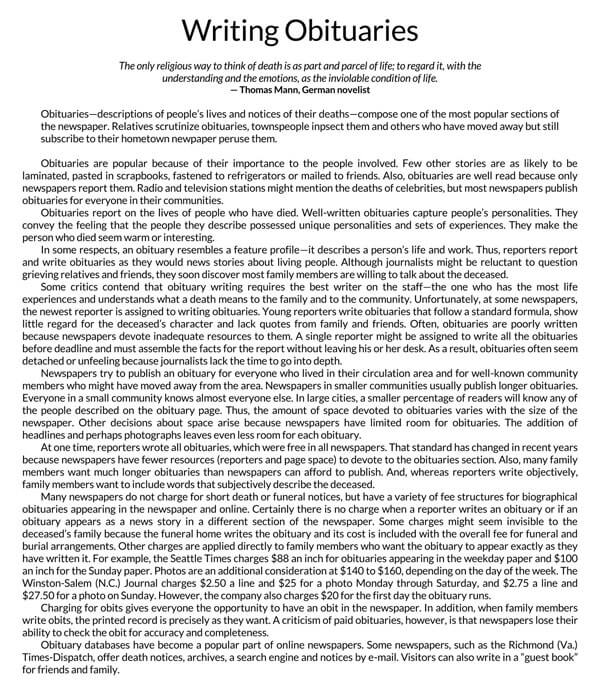


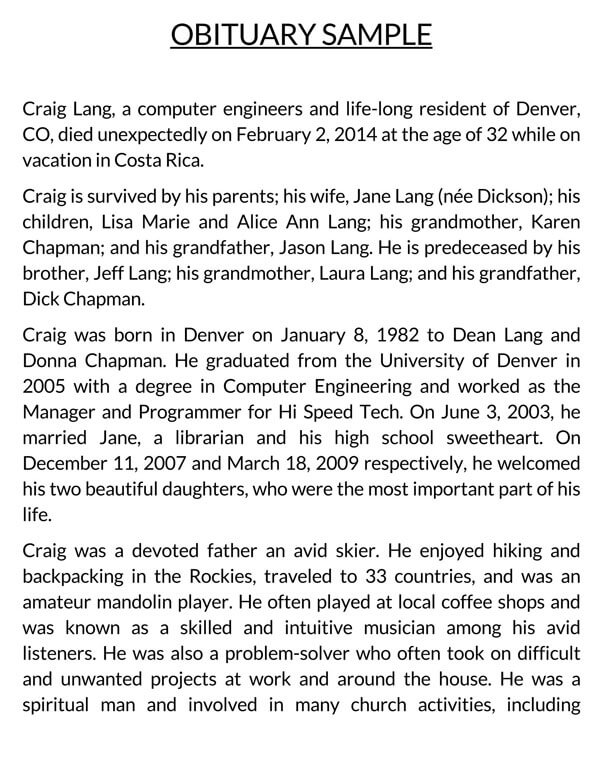
How Many Words Should an Obituary be?
The average length for an obituary could be 200 words; however, it can be as few as 100 words and it could be as long as 450 words. It would depend on the content that is being used.
What is a Newspaper Obituary?
It is the announcement of the death of a person in a newspaper, which gives certain information.
The purpose of the newspaper obituary is to let people know that this person is no longer alive. It is not easy to lose a loved one and it would be tough to let everyone know that a certain person is no longer with us and hence, giving the news of their death in the newspaper would be a good idea as it would let people know about the death.
How do You get an Obituary in the Newspaper?
It is possible to get an obituary in the newspaper online and the funeral home can also assist in submitting the death notices on behalf. However, when submitting the obituaries it is important to follow the rules and regulations if any. Getting an obituary in Newspaper has become easier thanks to the power of the internet and information technology.
Frequently Asked Questions
An obituary, or an obit, is a newspaper article that publicly states a person’s death, giving a short account of their lifetime and details about the upcoming funeral.
It is not mandatory to have an obituary when someone dies. But, an obituary, or an online death notice, is a moral way to share news of the demise with family, friends, colleagues, and people at large.
Writing an obituary is all about the personal details of the deceased person. It is usually written by someone close to the deceased, like a family member or a friend. Some funeral service providers also offer to help.
The purpose of this is to inform the public about the demise of the near one. For prominent people who have a high profile status, their obituary is published in local and national newspapers. Nowadays, giving online notices is also getting widespread.
Death notices usually contain basic information about the deceased person. His full name, date of birth, place of birth, and age. Whereas in an obituary, apart from the key facts, a concise life sketch of the deceased person together with the names of his immediate family members is also included.
